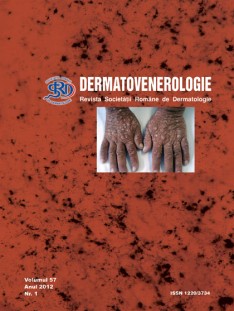Clinical cases
Loxoscelism - first observations in Romania
Introduction:
Loxoscelism is a condition caused by bite venom of Loxosceles spider developing a characteristic clinical appearance. Loxosceles are spiders that are found throughout the world especially in Nord America, South America and South of Europe. We present the case of a man bitten by a spider and presenting the clinical aspect of loxoscelism.
Clinical case:
A 59-year old male patient with unremarkable medical history found, few hours after multiple spider bites, an inflammatory patch on his left forearm. In the next day, dermatological examination revealed a painful inflammatory area on the left forearm that was tending to grew larger and to develop large blisters. The inflammatory area surrounded a white ischemic zone and in the center a cyanotic area, achieving the “red, white and blue sign”. Biological examinations were normal and bacteriological tests were negative. The course was to a large necrotic ulceration. Treatment consisted in symptomatic drugs, antibiotic, tetanus booster. Surgical debridation was made in 42-th day of disease followed by complete healing of ulceration. After 6 months no relapse was noted.
Discussion:
Loxoscelism is caused by the venom of Loxosceles spiders. The bite is little or no painful but is followed in few hours by development of a tender inflammatory plaque with centrifugal evolution, with central vesicle or blister, that after three days get the characteristic appearance of “red, white and blue” from margins to center. In 10% to 15% of cases a deep necrotic ulceration appears. Ideally, the diagnosis of loxoscelism is based on the capture and the identification of the spider in the act of biting, but in endemic areas spider collection and identification is not necessary for diagnosis. Treatment includes symptomatic measures, antibiotics and tetanus booster.
Conclusion:
Loxoscelism is a cause of deep localized cutaneous necrosis, as well with possibility to occur in Romania.
Loxoscelism is a condition caused by bite venom of Loxosceles spider developing a characteristic clinical appearance. Loxosceles are spiders that are found throughout the world especially in Nord America, South America and South of Europe. We present the case of a man bitten by a spider and presenting the clinical aspect of loxoscelism.
Clinical case:
A 59-year old male patient with unremarkable medical history found, few hours after multiple spider bites, an inflammatory patch on his left forearm. In the next day, dermatological examination revealed a painful inflammatory area on the left forearm that was tending to grew larger and to develop large blisters. The inflammatory area surrounded a white ischemic zone and in the center a cyanotic area, achieving the “red, white and blue sign”. Biological examinations were normal and bacteriological tests were negative. The course was to a large necrotic ulceration. Treatment consisted in symptomatic drugs, antibiotic, tetanus booster. Surgical debridation was made in 42-th day of disease followed by complete healing of ulceration. After 6 months no relapse was noted.
Discussion:
Loxoscelism is caused by the venom of Loxosceles spiders. The bite is little or no painful but is followed in few hours by development of a tender inflammatory plaque with centrifugal evolution, with central vesicle or blister, that after three days get the characteristic appearance of “red, white and blue” from margins to center. In 10% to 15% of cases a deep necrotic ulceration appears. Ideally, the diagnosis of loxoscelism is based on the capture and the identification of the spider in the act of biting, but in endemic areas spider collection and identification is not necessary for diagnosis. Treatment includes symptomatic measures, antibiotics and tetanus booster.
Conclusion:
Loxoscelism is a cause of deep localized cutaneous necrosis, as well with possibility to occur in Romania.


